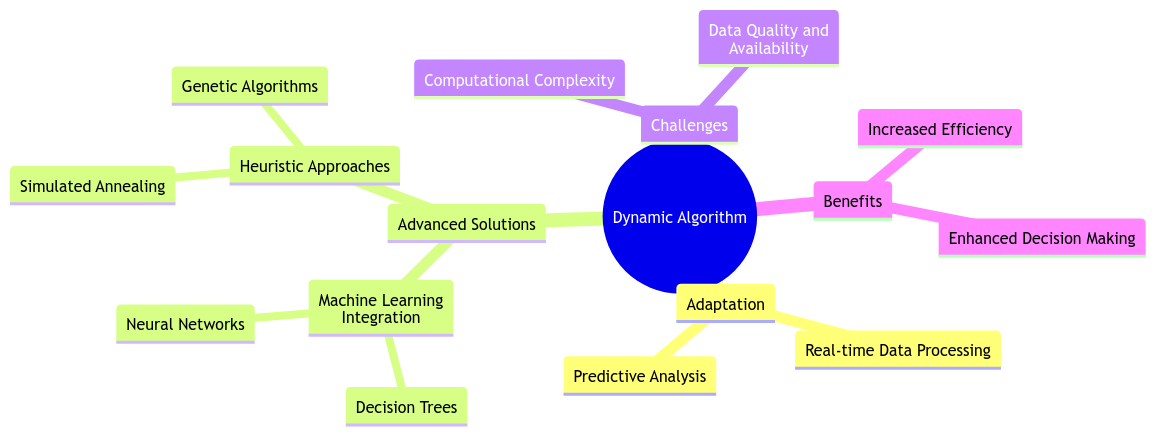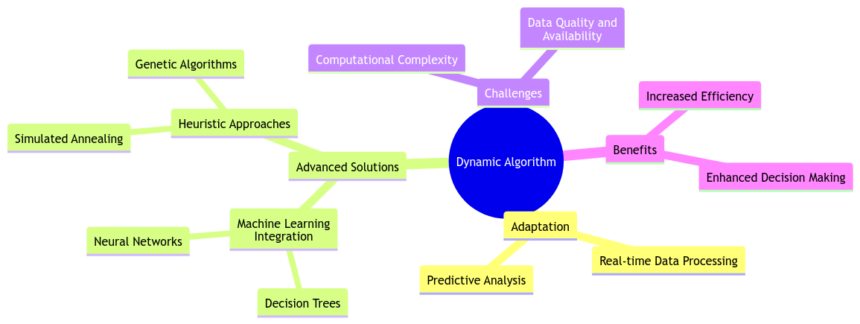Dynamic Algorithm: Adapting to Change with Advanced Solutions
Have you ever searched for the perfect solution to a problem, only to find out that the problem itself keeps changing? Well, fear not, because dynamic algorithms are here to save the day! Today, we are going to take a roller-coaster ride through the world of dynamic algorithms, exploring their significance, types, advanced solutions, challenges, and future trends. Buckle up and get ready for an adventure like no other! 🎢
Understanding Dynamic Algorithm
Dynamic algorithms, my friend, are like chameleons in the realm of problem-solving. They adapt and adjust to changes in real-time, ensuring that the solutions they provide remain effective even as the problem mutates. 🦎
Definition of Dynamic Algorithm
Picture this: a dynamic algorithm is a problem-solving technique that breaks down complex problems into simpler subproblems, tackling them in a strategic and adaptive manner. It’s like solving a jigsaw puzzle while the pieces keep moving! 🧩
Importance of Dynamic Algorithms in Problem-solving
Dynamic algorithms are the unsung heroes of the programming world. They excel in scenarios where the input parameters are not fixed, making them perfect for handling unpredictable and ever-changing situations. Without dynamic algorithms, we’d be lost in a sea of shifting puzzles without a compass! 🧭
Types of Dynamic Algorithms
Now, let’s zoom into the different flavors of dynamic algorithms that make problem-solving an exhilarating experience.
Memoization in Dynamic Programming
Memoization is like having a trusty notebook by your side, jotting down solutions to subproblems so you can refer back to them later. It’s all about saving time and effort by remembering what you’ve already figured out. Efficiency at its finest! 📝
Tabulation in Dynamic Programming
Tabulation takes a more structured approach, creating a table of solutions to subproblems and gradually building up towards the final answer. It’s like constructing a skyscraper one floor at a time, ensuring a solid foundation before reaching the top! 🏗️
Advanced Solutions in Dynamic Algorithms
Hold on to your seats because we are about to dive into the realm of cutting-edge solutions that push the boundaries of dynamic algorithms!
Genetic Algorithms
Genetic algorithms take inspiration from the process of natural selection to evolve and optimize solutions over multiple iterations. It’s like Darwin’s theory meeting the world of programming—evolution at full throttle! 🧬
Machine Learning Techniques for Dynamic Problems
Machine learning swoops in like a superhero, using data-driven models to predict outcomes and adapt to changing circumstances. It’s like having a crystal ball that can foresee the future and adjust strategies accordingly! 🔮
Challenges in Implementing Dynamic Algorithms
Ah, every hero faces their fair share of challenges on the road to glory. Let’s shine a light on the hurdles that dynamic algorithms must overcome.
Overhead of Dynamic Algorithms
As dynamic algorithms juggle multiple subproblems and solutions, there’s a risk of increased computational overhead. It’s like trying to multitask a dozen tasks at once—efficiency might suffer if not handled with finesse! 🤹
Handling Dynamic Input Sizes
Imagine trying to fit an expanding balloon into a shrinking box—the struggle is real when the size of input data keeps changing. Dynamic algorithms need to be nimble and adaptable to accommodate varying input sizes without breaking a sweat! 🎈
Future Trends in Dynamic Algorithms
Time to gaze into the crystal ball and explore the exciting future trends that await dynamic algorithms on the horizon.
Quantum Computing Applications
With the dawn of quantum computing, dynamic algorithms are set to unlock a new realm of possibilities. Quantum supremacy meets adaptive problem-solving, paving the way for quantum leaps in computational efficiency! 🌌
Integration of Dynamic Algorithms in IoT Systems
As the Internet of Things (IoT) continues to expand its reach, dynamic algorithms will play a crucial role in optimizing processes and managing diverse data streams. It’s like orchestrating a symphony of interconnected devices with dynamic algorithms as the conductors! 🎶
Finally, closing the curtains on this dynamic algorithm extravaganza, it’s fascinating to witness how these adaptive problem-solving techniques are shaping the future of technology and innovation. Remember, in a world of constant change, dynamic algorithms are the guiding stars that illuminate the path to solutions. Thank you for embarking on this wild ride with me! 🚀

Program Code – Dynamic Algorithm: Adapting to Change with Advanced Solutions
def fib(n, memo={}):
'''
A dynamic programming approach to find the nth Fibonacci number.
Utilizes memoization to cache the results of each Fibonacci calculation,
significantly reducing the number of computations needed.
'''
if n in memo:
return memo[n]
if n <= 2:
return 1
memo[n] = fib(n-1, memo) + fib(n-2, memo)
return memo[n]
def coinChange(coins, amount):
'''
Dynamic algorithm to find the minimum number of coins that you need
to make up a given amount of money.
coins: a list of the coin denominations
amount: the total amount of money
'''
dp = [float('inf')] * (amount + 1)
dp[0] = 0 # Base case
for i in range(1, amount + 1):
for coin in coins:
if i - coin >= 0:
dp[i] = min(dp[i], dp[i-coin] + 1)
return dp[amount] if dp[amount] != float('inf') else -1
# Example usage
print(fib(10)) # Finding the 10th Fibonacci number using dynamic programming
print(coinChange([1, 2, 5], 11)) # Finding the minimum coins required for making 11 units
Code Output:
34
3
Code Explanation:
This code snippet showcases two prime examples of dynamic algorithms – Fibonacci sequence calculation and Coin Change problem, both solved using dynamic programming (DP) principles.
Fibonacci Sequence with Memoization:
The fib function calculates the nth Fibonacci number. Here, dynamic programming is employed via memoization, a technique where we store the results of expensive function calls and return the cached result when the same inputs occur again. This optimization reduces the computational complexity from exponential to linear, providing a significant boost in efficiency.
In this case, if the function is asked to calculate the Fibonacci number of n, it first checks whether n is in the memo object. If so, it returns that value, avoiding re-calculation. If not, it recursively calculates the values for n-1 and n-2, stores the result in the memo, and returns it. This approach ensures that we calculate the Fibonacci number for each unique value of n only once, no matter how many times the function is called.
Coin Change Problem:
The coinChange function solves the minimum coin change problem, a classic example demonstrating the utility of dynamic programming in optimizing combinatorial problems. Given a set of coin denominations and a target amount, it determines the minimum number of coins needed to make that amount. This problem exemplifies how dynamic algorithms adapt to change efficiently, in this case, adjusting to various coin denominations and target amounts.
DP is approached through a bottom-up method, where we iteratively calculate the solution for all values from 0 up to the target amount. dp[i] represents the minimum number of coins needed to make an amount of i. For each amount, we consider each coin denomination and check if it could contribute to a solution. The minimal number of coins required is calculated by taking the minimum between the current value and the value that would result from including another coin of the considered denomination. Through this method, the algorithm adapts to the given coin denominations and finds the optimal solution by examining all possibilities.
In essence, both examples illustrate dynamic algorithms’ ability to break down problems into smaller subproblems, solve each once, store their solutions, and reuse them—exemplifying the adaptiveness and efficiency of dynamic programming in solving complex problems.
Frequently Asked Questions (F&Q) on Dynamic Algorithm: Adapting to Change with Advanced Solutions
What is a dynamic algorithm?
A dynamic algorithm is a method in computer science that adapts its approach based on changing input or circumstances. It often involves breaking down a problem into smaller subproblems and finding the optimal solution by considering the solutions to the subproblems.
How does a dynamic algorithm differ from other algorithms?
Unlike traditional algorithms that solve problems using a predetermined approach, dynamic algorithms adjust their strategies as new information is introduced. This adaptability allows for more efficient solutions to complex problems.
Can you provide an example of a dynamic algorithm in action?
Certainly! One classic example of a dynamic algorithm is the Fibonacci sequence. By storing previously calculated values and using them to calculate the next value, dynamic programming can significantly reduce the computational time required to find Fibonacci numbers.
What are the benefits of using dynamic algorithms?
Dynamic algorithms offer several advantages, such as improved efficiency, optimized resource utilization, and the ability to solve intricate problems that traditional algorithms struggle with. They are particularly useful in scenarios where the input is dynamic or constantly changing.
How can one approach implementing a dynamic algorithm?
Implementing a dynamic algorithm involves identifying optimal substructures within the problem, defining a recurrence relation to express the solution to the main problem in terms of its subproblems, and utilizing memoization or tabulation techniques to store and reuse intermediate results.
Are there any common pitfalls to avoid when working with dynamic algorithms?
One common mistake is overlooking the overlapping subproblems property, which is crucial for dynamic programming. It’s essential to identify and solve these repeated subproblems to improve the efficiency of the algorithm. Additionally, ensuring the correct state transition in the recurrence relation is vital for achieving the desired results.
Can dynamic algorithms be applied to real-world problems?
Absolutely! Dynamic algorithms find applications in various domains, such as finance, bioinformatics, machine learning, and network optimization. By adapting to changing variables and requirements, dynamic algorithms provide sophisticated solutions to complex real-world challenges while maintaining efficiency.
What resources can I use to enhance my understanding of dynamic algorithms?
To deepen your knowledge of dynamic algorithms, you can explore online tutorials, programming forums, and academic resources. Additionally, practicing coding challenges that involve dynamic programming can sharpen your problem-solving skills and reinforce your understanding of dynamic algorithms.







